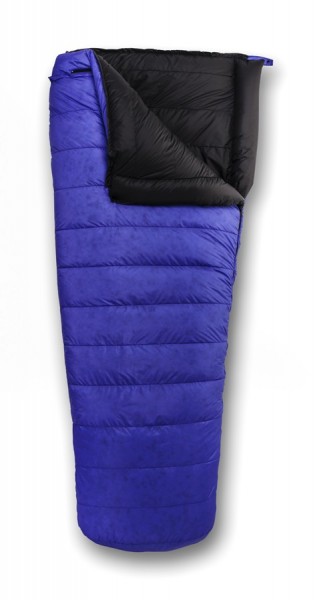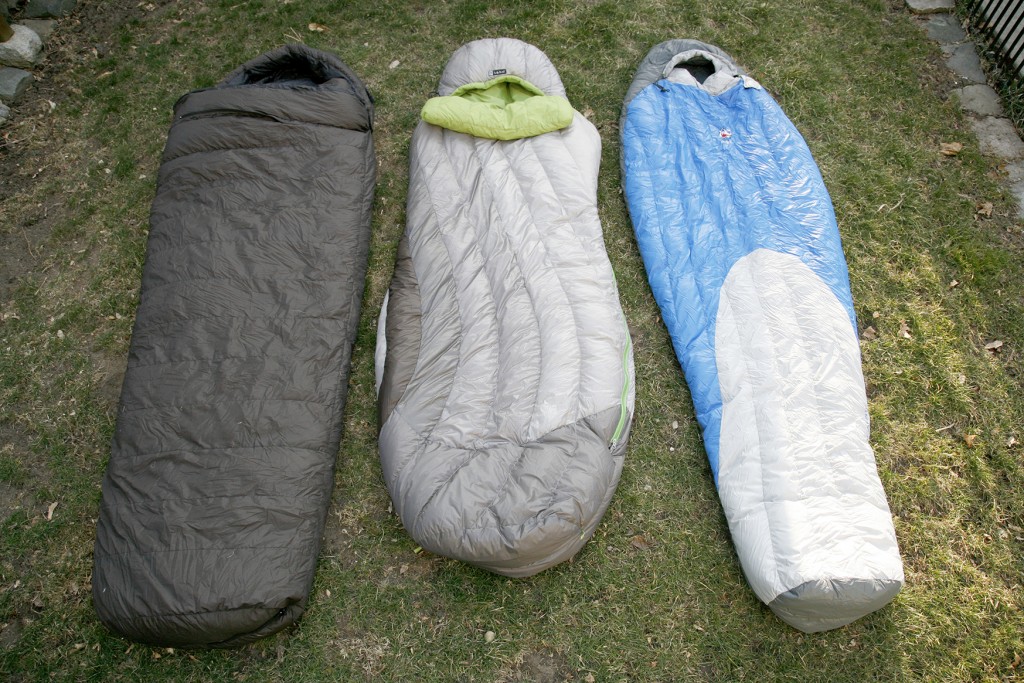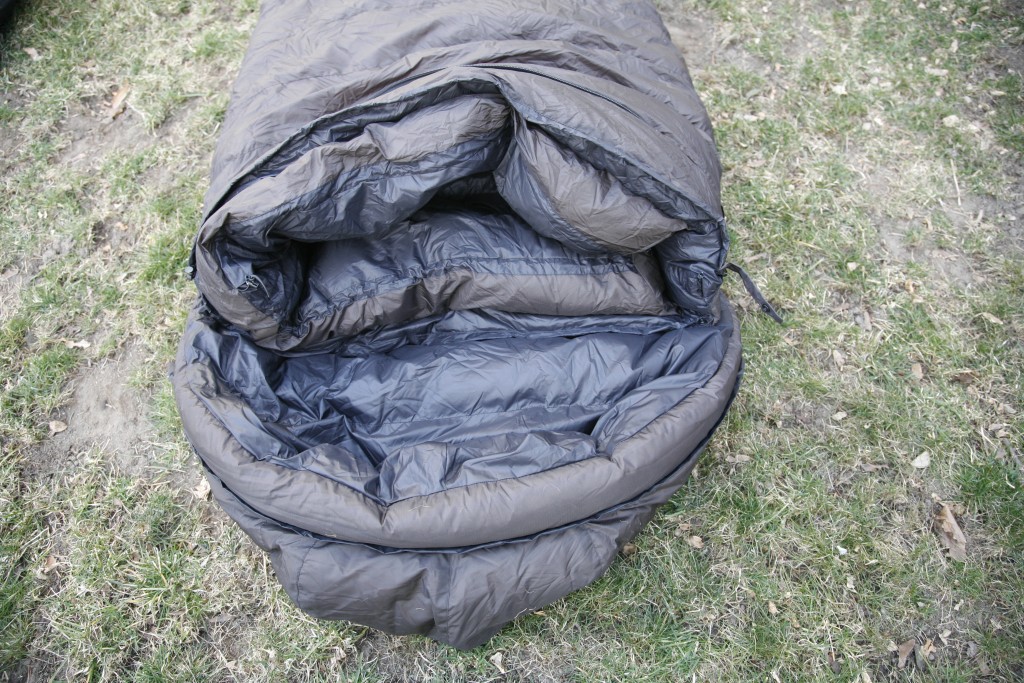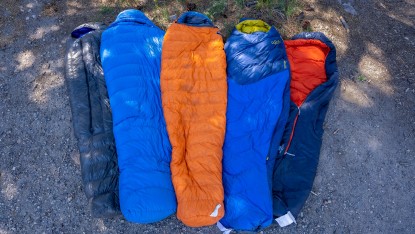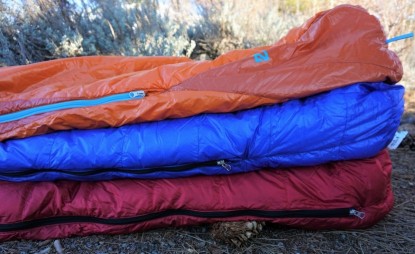Feathered Friends Penguin 20 Review
Our Verdict
Our Analysis and Test Results
Design Overview
The Penguin is a semi-rectangular down sleeping bag that uses 850+ fill down, top-tier shell fabrics, and can be used with an optional Groundsheet to create a supremely comfortable bed-like two-person sleeping bag. The bag can be used in one person mode, without the Groundsheet, for optimal warmth and thermal efficiency with one person, or with the Groundsheet for luxurious comfort with one person or tremendously warm and snuggly comfort with two. Many sleeping bags try to be comfortable, warm, and lightweight simultaneously, but no other bag we've tested succeeds at blending these objectives to the degree that the Penguin does.
Comfort
The Penguin is the most comfortable down sleeping bag we've ever tested. (As of 5/28/13) OutdoorGearLab has published reviews for 55 down sleeping bags across all categories from expedition winter to ultralight summer.) The Penguin's semi-rectangular shape provides more space and more comfort than the typical mummy bag that tapers drastically in the lower half. This design gives you more room to move around within the sleeping bag, rather than with the bag, like trim cut mummies. Although the bag is remarkably comfort when used in one-person mode it gets even more comfortable when used in two-person mode in conjunction with the Groundsheet. The abundant space combined with the soft, buttery interior fabric and makes it feels like you are actually sleeping in a bed!! When used with the Groundsheet the Penguin is arguably more comfortable than the Slumberjack Country Squire, a gigantic car camping bag with an integrated sheet.
Warmth
The Penguin is available in 10, 20, 30, and 40-degree models so you can choose the level of warmth that best suits you needs. We feel that the 20-degree version will be best for people that want to use the bag for car camping and backpacking in a variety of three-season conditions. If you plan to primarily use the bag with another person also consider going for a lighter model; seeping with two people in the bag is very warm. Based on our tests we estimate that with two bodies the bag is comfortable to at least 15 degrees below its rating!! This makes it a viable winter setup for two people; you can save a tremendous amount of weight and money by choosing the Penguin over two separate winter sleeping bags.
It's Missing a Hood?!
Yes, and this a good thing. Hood-less sleeping bags have three significant advantages over their hooded counterparts: (1) They're more comfortable. Only a handful of the 70+ sleeping bags we've tested have hoods that are truly comfortable when cinched tight. Separating the hood from the bag allows you to turn over without getting lost inside the hood and without spewing moisture vapor into the bag (which adds weight and reduces loft). Our testers agree that hoodless bag are more comfortable than bags with hoods. (2) Hoodless bags are lighter! Most people do the majority of their backpacking in summer when hoods are rarely needed. Why carry it if you don't need it? (3) Hoodlless bags cost less to manufacture. Why pay the additional cost of a hood if you don't need one?
However, if you plan to camp in temperatures around or below freezing we recommend a hood. Know that you can purchase a hood separately from a few manufacturers and retailers.
Weight
The Penguin 20 weighs 43 ounces, or 2 lb. 11oz., which is on the heavy side for lightweight backpacking. For people that go on several 1-7 night backpacking trips each year this weight won't be too cumbersome (most synthetic mummy bags weigh more than the Penguin). Many of our testers are willing and eager to carry the bag on trips because it's so comfortable—they sleep better. If you plan to share the Penguin with another person the bag weighs a mere 21.5 ounces per person, or 27.5 oz per per person with the Groundsheet, which makes it quite light given its tremendous warmth and comfort. Sharing, after all, is a key component of going light. For a fun, quick read, see Patagonia alpine climbing ambassador Kelly Cordes' piece about the ManSpoon, a.k.a. sharing one bag with two men.
The Penguin packs down small considering its comfort and warmth. Its top quality 850+ fill down is highly compressible and has the added advantage of being more durable than lower fill powers. Down also continues to insulate longer term than synthetic insulation.
Versatility
The Penguin is versatile in the sense that it is be single best bag we've tested for people that want one bag for both comfortable car camping and weight conscious backpacking trips. Its design is not as versatile as bags with continuous horizontal baffles (see the Feathered Friends Hummingbird
Limitations
Feathered Friends bags come with decent stuff sacks that don't do a lot to keep water out. An after-market stuff or compression sack might be in order to keep your bag dryer and less grimey. Check our Best Sleeping Bag Stuff Sack Article for our top recommendations.
Value
Despite its $439 price tag the Penguin 20 is a fantastic value. It's stuffed with tons of expensive top-quality down, uses great fabrics, and will last for a decade (likely more) of adventuring. Plus, it's hard to put a dollar value on a good night's sleep that comes partly from a very comfortable sleeping bag.
To best compare the Penguin's value with others check out the Backpacking Sleeping Bag Price Versus Value Chart.
The Penguin's other versions cost: 10-degree $479, 30-degree $369, 40-degree $339.
Note: Also consider purchasing a cheap camping sleeping bag, which costs as little as $40, and an Ultralight Sleeping Bag, which costs as little as $260. Depending on your use, two bags may offer more performance and cost less than the Penguin.
Accessories
As briefly described above, the Penguin Hood weighs 5.6 ounces, costs $65, and zips to the back of the bag. We found this hood to be very effective at keeping the back and sides of our head warm, but it's not as effective as fixed hoods at keeping your face warm. It performs least well when used in two person mode because the center side does not snap to anything and bunches up when you cinch the drawcord- adding a snap feature to the center would increase comfort for people that want to use the bag in below freezing conditions with two Penguin Hoods. For most people, and particularly for car campers, these limitations will not be a significant unless you are using the bag around or below its temperature rating. And again, our testers prefer the ZPacks Goose Hood, which costs the same amount, for maximum warmth to weight ratio.
The Penguin Groundsheet is a superb $70 accessory that really makes the Penguin. It zips to the bag to create one enclosed sack and features: two sleeves for 20" wide sleeping pads (this creates a remarkably bed-like surface for sleeping), has a soft fleecy interior lining, and weighs 13 oz on our scale. Many of our testers use the bag with this attached even when sleeping alone in the bag with one sleeping pad beneath the Groundsheet, not inserted inside. The extra bag hangs down over the edges of the pad in a way that reduces dead air space.

